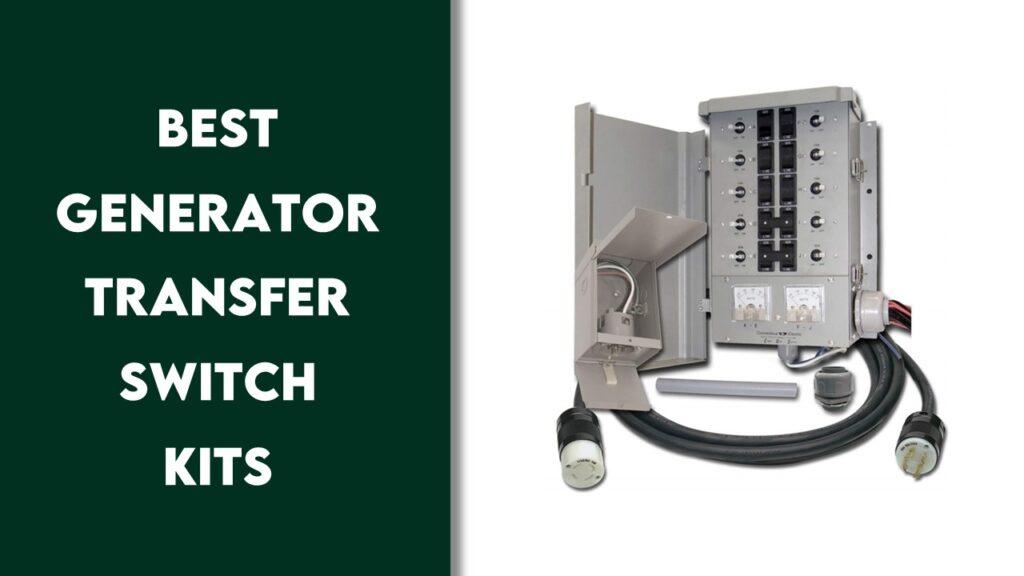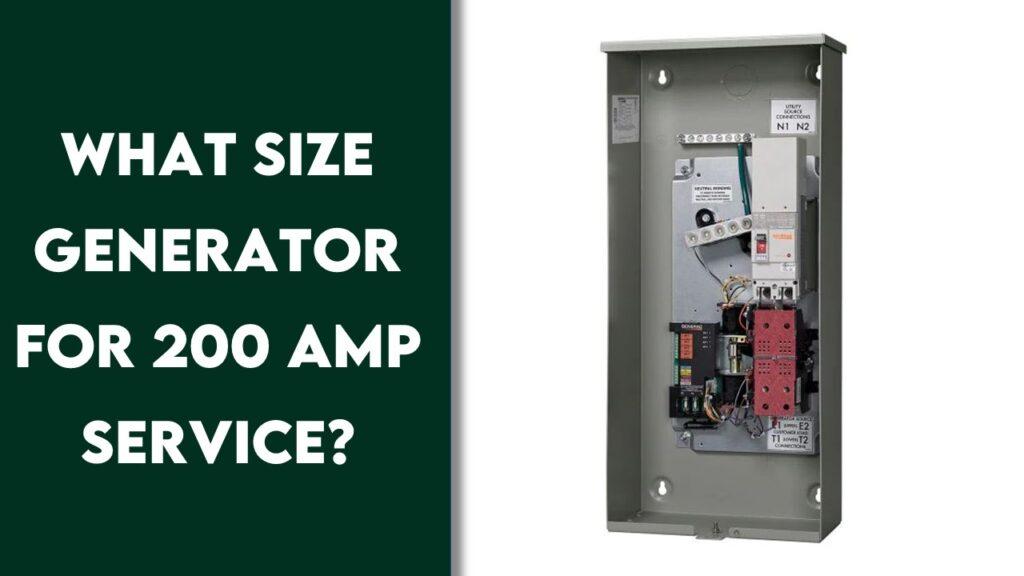Generator cords are those heavy-duty cables you need to connect your generator to whatever you’re powering, making sure the electricity flows safely and gets the job done. In this guide, we have extensively researched, reviewed, and ranked the 10 best generator cords in 2025.
We’re reader-supported. When you buy through links on our site, we may earn an affiliate commission. As an Amazon Associate, we earn from qualifying purchases.
Our Top 10 Picks of The Best Generator Cords
1. Best Overall Option: PlugSaf 50FT 30 Amp Generator Extension Cord
2. Best Budget-Friendly Option: GEARit 30-Amp Generator Extension Cord
3. Value Option: Champion Power Equipment Generator Power Cord
4. RV Camping Option: RVGUARD 50 Amp 15 Foot RV Power Cord
5. Heavy-Duty Option: CircleCord UL Listed 50 Amp 25 Feet RV/Generator Cord
6. Compact Option: Southwire 20-Foot 30Amp Generator Cord
7. Waterproof Option: RVINGPRO 50 Amp Generator Cord
8. High-Power Option: YOMILINK 50 Feet 50 Amp RV/Generator Cord
9. Flexible Length Option: Kohree Nema L14-30 Generator Cord
10. Power Inlet Box Option: LANDNOR 50AMP 15Feet Generator Cord
What Is The Best Generator Cord In 2025?
Choosing the right generator cord for 2025 isn’t always straightforward. With evolving options, it’s important to find one that suits your needs. Moreover, a reliable cord ensures safety and maximum power efficiency. Here’s a closer look to help you make the right choice:
1. Best Overall Option: PlugSaf 50FT 30 Amp Generator Extension Cord
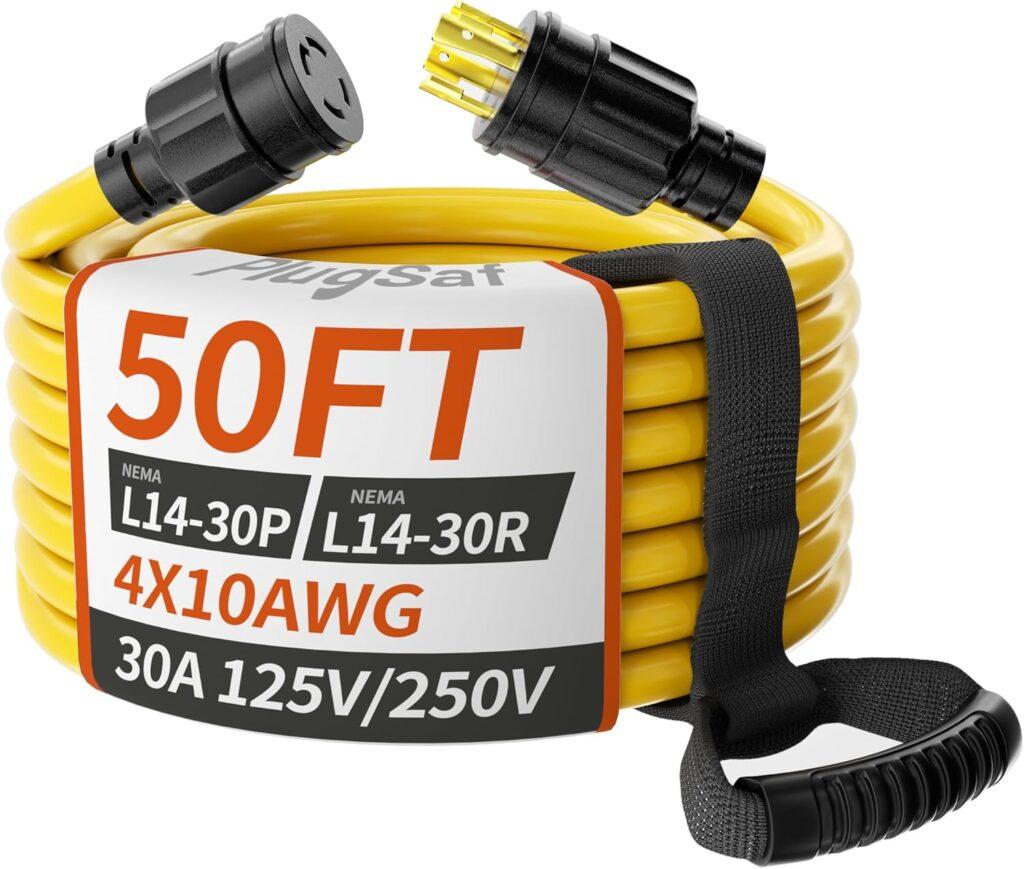
Quick Specifications
- Brand: PlugSaf
- Connector Gender: Male-to-Female
- Voltage: 250 Volts
- Input Current: 30 Amps
- Wattage: 7500 watts
- Gauge: 10.0
- Number Of Conductors: 4
- Number of Outlets: 1
If you’re looking for a solid, long, and tough generator cord, this one definitely delivers. The 50-foot length is great because it gives enough space to keep your generator at a safe distance while still powering everything you need. Plus, it’s got a thick, durable build, so you don’t have to worry about it wearing out anytime soon. It’s not one of those flimsy cords that you have to replace every year.
One thing that stands out, from our perspective, is the twist-lock plug. This little feature helps a lot, especially in bad weather or if the generator is running on uneven ground. Nothing’s worse than a power interruption because the cord came loose. The weather resistance is also a huge plus—rain, sun, or even freezing temperatures, this thing holds up. It’s flexible enough to roll up and store without fighting you, but still tough where it matters.
Pros
- Built strong and heavy-duty, so it lasts.
- Twist-lock plug keeps everything secure, no accidental disconnects.
- Handles all kinds of weather—rain, heat, and cold don’t bother it.
- Flexible but not flimsy, making storage and setup easier.
Cons
- A bit on the bulkier side, takes up space when storing.
- Not UL listed, but still meets ETL safety standards.
From our standpoint, this generator cord does exactly what it should—no fuss, no problems. It’s strong, reliable, and safe, making it a practical pick for anyone who needs a long, secure, and weatherproof connection. The twist-lock feature alone makes it worth considering, especially if you don’t want to deal with random unplugging. Plus, it’s built tough enough to handle daily use without falling apart. If you need a solid generator cord that actually holds up, this one’s a proper choice.
2. Best Budget-Friendly Option: GEARit 30-Amp Generator Extension Cord

Quick Specifications
- Brand: GearIT
- Connector Gender: Male-to-Female
- Voltage: 250 Volts
- Input Current: 30 Amps
- Wattage: 7500 watts
- Gauge: 10.0
- Number Of Conductors: 4
- Number of Outlets: 1
If you’re looking for a budget-friendly generator cord that still holds up well, this one is worth considering. It’s a solid generator extension cord for short-distance connections, especially for portable generators or transfer switches. At 10 feet, it’s not the longest option, but for keeping the generator close without unnecessary excess cord, it does the job. The oxygen-free copper wiring helps ensure stable power delivery, which is always important when running appliances or backup power.
One thing that stands out, from our perspective, is the twist-lock plug. It keeps the connection secure, so there’s no worry about it coming loose in bad weather or when the generator is running for hours. The bright green color also makes it easy to spot, which is useful when working in low light or around other cables. If you need a short, tough, and reliable generator extension cord for emergency power or home backup, this one is a practical choice.
Pros
- Sturdy build, designed to handle regular use without wearing out.
- Twist-lock plug keeps the generator cord securely connected.
- Bright green jacket makes it easy to find, even in poor lighting.
- Weather-resistant, so it works well for outdoor setups.
Cons
- Only 10 feet long, so may not work for setups needing more distance.
- A bit stiff at first, but gets easier to handle over time.
From our standpoint, this generator extension cord does exactly what it needs to do. The secure connection, durable materials, and reliable power transfer make it a proper option for those who need a short and dependable generator cord without spending too much. While it may not be the best for long-distance setups, it’s a good choice for those looking for something simple, sturdy, and effective.
3. Value Option: Champion Power Equipment Generator Power Cord

Quick Specifications
- Brand: Champion Power Equipment
- Connector Gender: Male-to-Female
- Voltage: 250 Volts
- Input Current: 30 Amps
- Wattage: 7500 watts
- Gauge: 10.0
- Number Of Conductors: 2
- Number of Outlets: 1
If you’re looking for a generator cord that gets the job done without any hassle, this one is worth considering. It’s 25 feet long, which is a solid length—not too short, not so long that it gets tangled up. From our perspective, it’s built well, feels sturdy, and holds up in different weather conditions, which is always a plus. Whether you’re hooking up a generator extension cord for backup power or running an outdoor setup, this one gives a reliable connection without much fuss.
One thing we really like is the twist-lock plug. It stays put, even if the cord gets moved around or there’s a storm outside. Nothing’s worse than losing power because your cord slipped out. Another thing that stands out is the heat and cold-resistant insulation, which keeps it flexible even in freezing temperatures. It’s a little on the heavier side, but honestly, that’s not a dealbreaker. It just means it’s made to last.
Pros
- Stays flexible even in extreme temperatures, so it’s easy to handle.
- Twist-lock plug keeps everything securely connected, avoiding accidental unplugging.
- 25-foot length is a good balance—not too short, not too bulky.
- Weather-resistant, so you don’t have to worry about rain or harsh conditions.
Cons
- A bit heavier than some other generator cords, but not unmanageable.
- Only two conductors, which might not work for every setup.
From our standpoint, this generator extension cord is a solid pick if you want something reliable and built to last. It does what it’s supposed to—keeps power running without interruptions, holds up in tough conditions, and doesn’t feel flimsy. While it’s a bit on the heavier side, that just adds to its durability. If you need a dependable generator cord for home backup or outdoor use, this one’s a great choice.
4. RV Camping Option: RVGUARD 50 Amp 15 Foot RV Power Cord
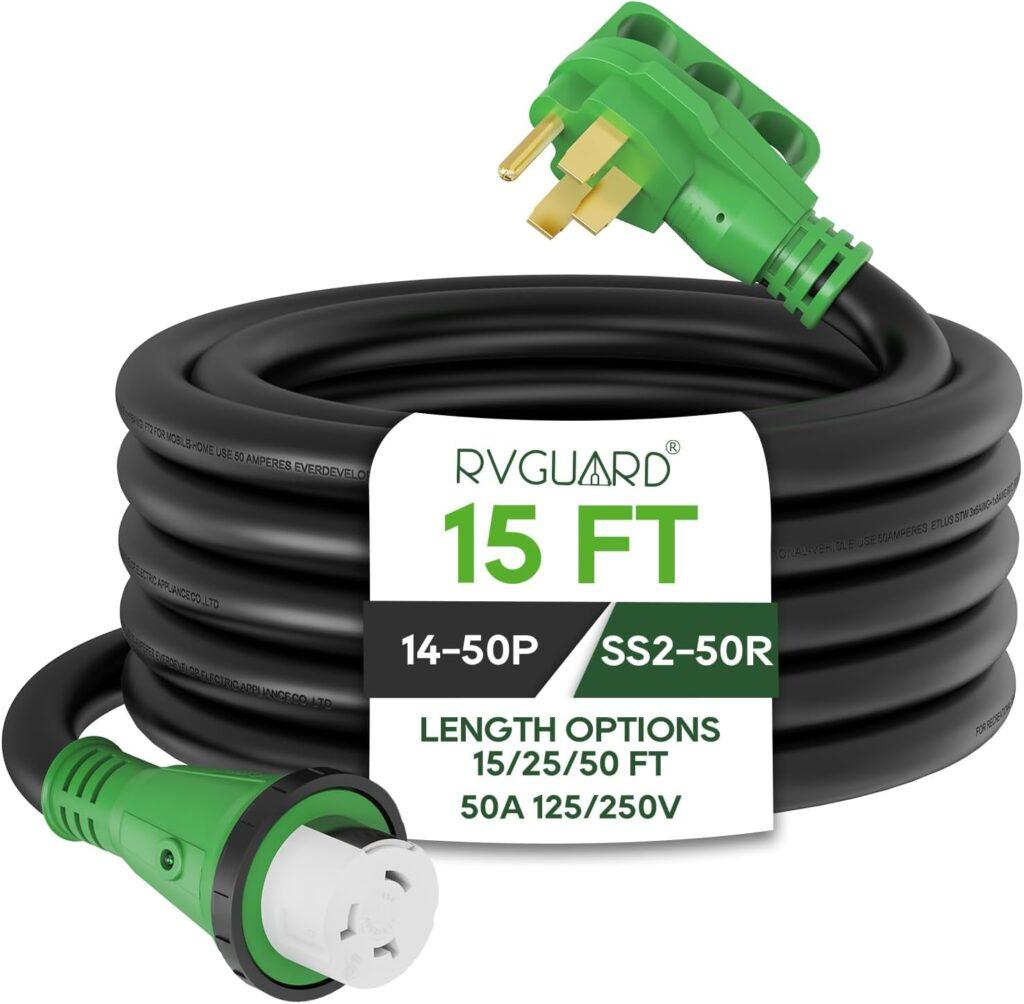
Quick Specifications
- Brand: RVGUARD
- Connector Gender: Male-to-Female
- Voltage: 250 Volts
- Input Current: 50 Amps
- Wattage: 12,500 watts
- Gauge: 6/3+8/1 STW
- Number Of Conductors: 4
- Number of Outlets: 1
Not every generator extension cord is built with RV camping in mind, but this one checks a lot of boxes. It’s tough, flexible, and designed to handle high power loads without issues. The 15-foot length keeps things manageable, making it easier to store without dealing with unnecessary bulk. From our standpoint, the locking connectors make a real difference, ensuring a secure fit so the cord stays put even in rough weather or during movement.
Something that stands out is the LED power indicator—a simple but useful touch that lets you know if the cord is live. The disconnect handle is another smart feature, making it easier to plug and unplug without yanking on the cable. Plus, the included storage bag and strap help keep it from becoming a tangled mess when not in use. If you need a durable and travel-friendly generator cord that’s made for RVs, this one seems like a practical pick.
Pros
- Feels sturdy and built to last through heavy use.
- Locking connectors help prevent unexpected power loss.
- LED indicator makes it easier to confirm power status.
- Comes with a storage bag and strap to keep things organized.
Cons
- A bit heavier than some might expect, but that’s due to the thick build.
- 15 feet may not be enough for larger RV setups.
From our perspective, this generator cord is well-suited for RV owners who want something reliable and easy to use. The secure locking feature, power indicator, and storage-friendly design make it a smart option for those who need a solid connection without hassle. While the length may not work for every setup, the quality and convenience make it a strong choice for camping and road trips.
5. Heavy-Duty Option: CircleCord UL Listed 50 Amp 25 Feet RV/Generator Cord

Quick Specifications
- Brand: CircleCord
- Connector Gender: Male-to-Female
- Voltage: 250 Volts
- Input Current: 50 Amps
- Wattage: 12,500 watts
- Gauge: 6/3+8/1 STW
- Number Of Conductors: 3
- Number of Outlets: 1
If you’re looking for a generator extension cord that feels like it can handle anything, this one is built tough. The 25-foot length makes it practical—not too short, not excessively long—and the thick, heavy-duty construction makes it clear this is designed for serious power use. From our standpoint, the locking connector is a great feature since it keeps everything secure, even in bad weather or when there’s movement.
One thing we really like is the ergonomic handle on the male end. Plugging and unplugging can be a struggle with stiff cords, but this grip makes it a whole lot easier. The outer coating also feels solid, offering protection from the elements, whether it’s rain, snow, or direct sun. It’s a bit heavier than some other cords, but that’s expected with a thick gauge build like this. If you need a strong, reliable generator cord for an RV, home backup, or even a job site, this one feels like a practical option.
Pros
- Thick, durable build that holds up well over time.
- Locking connector keeps the power secure, even if the cord moves around.
- Ergonomic grip makes it easier to handle and unplug.
- Includes a storage bag and an organizer to keep things neat.
Cons
- A bit heavy, but that’s common for heavy-duty cords.
- If not coiled correctly, the included organizer may not fit well.
From our perspective, this generator cord is all about durability and reliable power transfer. The secure locking feature, rugged insulation, and easy handling make it a solid choice for those who need a heavy-duty option that won’t let them down. It might be a little bulkier than some, but that’s a trade-off for a cord built to last. If you need something that’s made for serious power use, this one is definitely worth considering.
6. Compact Option: Southwire 20-Foot 30Amp Generator Cord

Quick Specifications
- Brand: Southwire
- Connector Gender: Male-to-Female
- Voltage: 125 Volts
- Input Current: 30 Amps
- Wattage: 3750 watts
- Gauge: 10/4
- Number Of Conductors: 1
- Number of Outlets: 1
This generator extension cord is a great pick for those who want something compact but still tough enough to handle the job. At 20 feet, it gives just enough length to keep the generator at a safe distance while avoiding unnecessary bulk. From our perspective, the twist-lock plug is a standout feature, keeping the connection tight and secure. The cord itself feels solid, and the heavy-duty jacket makes it well-suited for outdoor use.
Another thing we like is the weather-resistant design, which helps protect it from moisture, chemicals, and general wear. It’s flexible enough to coil up easily but still tough enough to hold up in rough conditions. If you’re looking for a compact, reliable generator cord for an RV, motorhome, or small backup setup, this one seems like a practical choice.
Pros
- Sturdy and compact design, making it easy to store and handle.
- Twist-lock plug ensures a firm and secure connection.
- Heavy-duty insulation holds up well against weather and abrasion.
- Just the right length for smaller generator setups without extra bulk.
Cons
- Might be too short for those needing extended reach.
- Not UL listed, but still made with durable materials.
From our standpoint, this generator extension cord is a solid mix of durability and convenience. The secure locking mechanism, tough exterior, and manageable length make it a proper fit for those who need a strong yet compact power solution. While the length may not work for every setup, the sturdy build and reliable performance make it a great choice for RVs and smaller power needs.
7. Waterproof Option: RVINGPRO 50 Amp Generator Cord
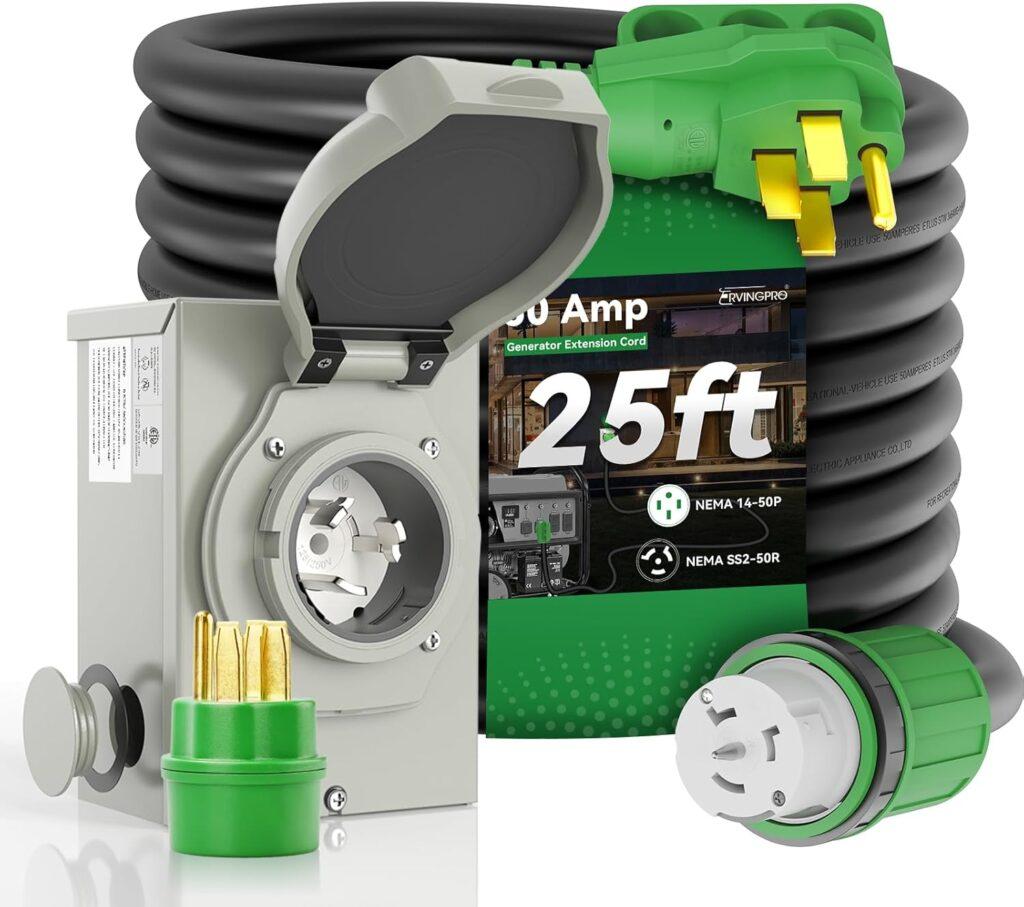
Quick Specifications
- Brand: RVINGPRO
- Connector Gender: Male-to-Female
- Voltage: 250 Volts
- Input Current: 50 Amps
- Wattage: 12,500 watts
- Gauge: 1.0
- Number Of Conductors: 3
- Number of Outlets: 1
A generator extension cord that’s waterproof and built for rough weather is always a good investment. This one stands out because it comes as a complete hookup kit, including both the generator cord and a pre-drilled power inlet box. From our perspective, having the inlet box included makes installation easier, especially for those who don’t want the hassle of drilling holes themselves. The twist-lock connection is also a great feature, helping to keep everything sealed against rain and dust.
Another thing we like is the indicator light on the inlet box, which lets you know when power is flowing. That’s a small but helpful feature, especially in emergencies. The ergonomic grip on the male plug makes plugging and unplugging easier, which isn’t always the case with heavy-duty cords. If you’re looking for a weather-resistant generator cord with a practical setup, this one seems like a proper fit.
Pros
- Comes with a pre-drilled power inlet box for easy installation.
- Twist-lock connector keeps the plug secure and prevents moisture from getting in.
- Indicator light helps confirm when the power is active.
- Ergonomic grip makes it easier to handle and unplug.
Cons
- Slightly bulkier due to the extra components, but manageable.
- Some units may not come with the adapter, so double-check before setup.
From our standpoint, this generator cord kit is built for convenience and tough weather conditions. The waterproof design, secure locking system, and additional inlet box make it a smart option for anyone needing a reliable and complete power hookup. While it’s a bit bulkier than a standard cord, the added functionality makes it a great choice for those who want a strong and weatherproof solution.
8. High-Power Option: YOMILINK 50 Feet 50 Amp RV/Generator Cord
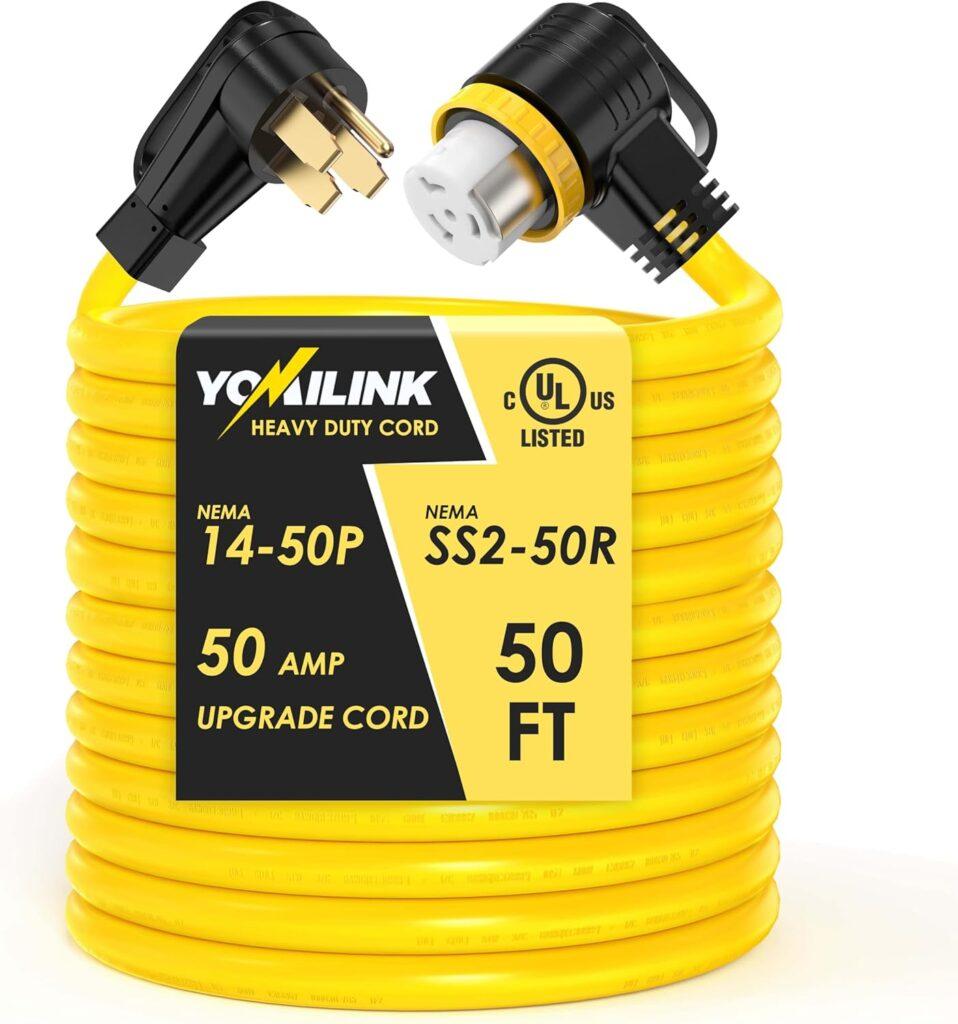
Quick Specifications
- Brand: YOMILINK
- Connector Gender: Male-to-Female
- Voltage: 125 Volts
- Input Current: 50 Amps
- Wattage: 12,500 watts
- Gauge: 6/3+8/1 STW
- Number Of Conductors: 4
- Number of Outlets: 1
If you need a generator extension cord that can handle serious power, this one delivers. The 50-foot length is great for setups where you need extra reach, whether it’s for an RV, a backup generator, or outdoor power needs. From our standpoint, the thick copper wiring and heavy-duty insulation make it feel durable and reliable. The 90° plug handle is also a nice touch, making it easier to grip and plug in without bending the cord too much.
One thing that stands out is the twist-lock connection, which keeps everything secure and prevents accidental unplugging. The weather-resistant coating is another plus, holding up against rain, heat, and cold without wearing out too quickly. It’s a bit on the heavier side, but that’s expected for a long, high-power generator cord. If you’re looking for something that can handle big power loads and last through regular use, this one seems like a practical choice.
Pros
- 50-foot length gives plenty of reach for bigger setups.
- 90° plug handle makes plugging and unplugging easier.
- Secure twist-lock connection prevents accidental disconnections.
- Tough insulation protects against weather and wear.
Cons
- A little bulky, but that’s expected with heavy-duty cords.
- Can feel stiff at first, but loosens up with use.
From our perspective, this generator cord is made for people who need serious power without worrying about durability. The locking plug, reinforced coating, and extra-long reach make it a solid option for anyone running an RV, a home backup system, or any heavy-duty generator setup. While it’s a bit bulkier than shorter cords, the build quality and reliability make it a strong pick for long-term use.
9. Flexible Length Option: Kohree Nema L14-30 Generator Cord
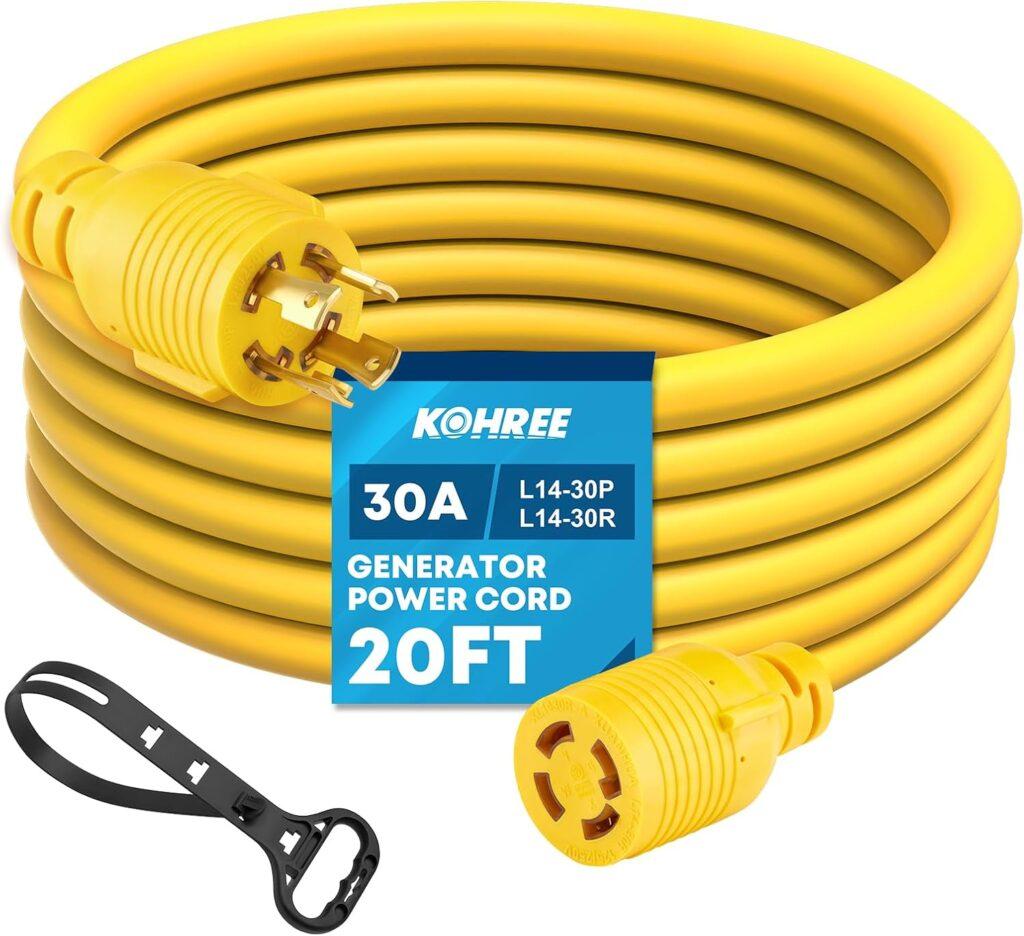
Quick Specifications
- Brand: Kohree
- Connector Gender: Male-to-Female
- Voltage: 250 Volts
- Input Current: 30 Amps
- Wattage: 7500 watts
- Gauge: 10.0
- Number Of Conductors: 4
- Number of Outlets: 1
A generator extension cord needs to be durable, secure, and easy to handle, and this one from Kohree delivers on all three. At 20 feet, it’s a good balance between reach and storage convenience. From our standpoint, the twist-lock plug is one of the best features, keeping the connection steady even in heavy rain or strong winds. The copper wiring and thick insulation also help it handle long-term use without overheating.
Something else we like is the included cord organizer, which helps keep things neat when the cord isn’t in use. The water-resistant and flame-retardant outer sheath adds to its durability, making it great for outdoor setups. It’s not the longest cord, but if you need a sturdy and flexible generator cord for emergency power or an RV hookup, this one seems like a practical choice.
Pros
- Twist-lock plug keeps the connection secure, even in rough weather.
- 20-foot length provides a good mix of reach and easy storage.
- Thick insulation prevents overheating and ensures long-term durability.
- Comes with a cord organizer for easy handling and storage.
Cons
- Might be too short for setups that require more distance.
- A bit stiff when new, but becomes more flexible over time.
From our perspective, this generator cord is all about reliability and ease of use. The secure locking connection, strong insulation, and weather-resistant design make it a solid option for those who need a dependable extension cord without excess bulk. While the length may not suit every setup, the flexibility and overall build quality make it a proper fit for home backup and outdoor power needs.
10. Power Inlet Box Option: LANDNOR 50AMP 15Feet Generator Cord
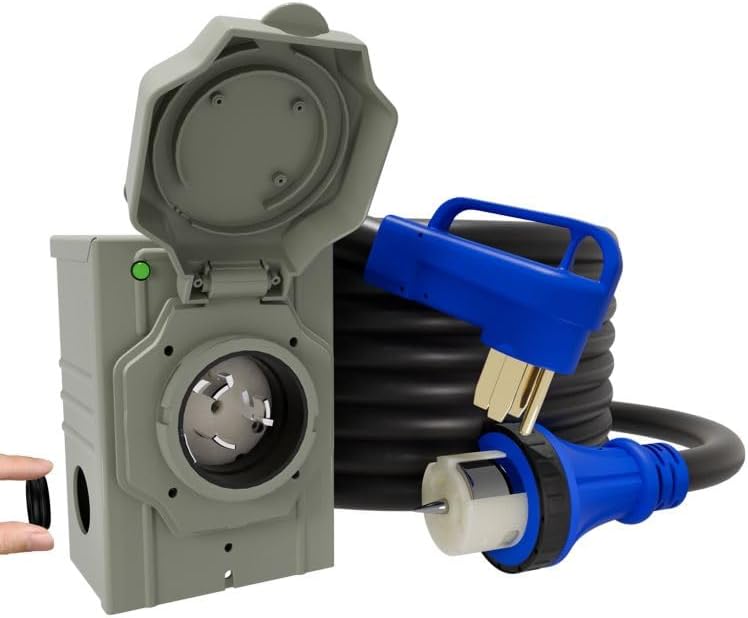
Quick Specifications
- Brand: LANDNOR
- Connector Gender: Male-to-Female
- Voltage: 125 Volts
- Input Current: 50 Amps
- Wattage: 12,500 watts
- Gauge: 1.0
- Number Of Conductors: 3
- Number of Outlets: 1
Having a generator extension cord with a pre-drilled power inlet box makes setup a lot easier, and this one does exactly that. From our perspective, the 15-foot length is a practical choice—long enough to maintain a safe distance but not so long that it becomes a hassle to store. The heavy-duty copper wiring and thick PVC jacket give it a tough feel, and the twist-lock connector ensures a secure fit, so there’s no risk of it coming loose in bad weather.
One thing that stands out is the pre-drilled power inlet box, which makes installation much more convenient. The rust-resistant coating and weatherproof flip-top lid also help protect it from the elements. The ergonomic grip on the male plug makes plugging and unplugging easier, especially in cold weather when cables tend to get stiff. If you’re looking for a generator cord and power inlet box combo that simplifies setup while offering solid performance, this one seems like a practical choice.
Pros
- Comes with a pre-drilled power inlet box for easier installation.
- Thick insulation and twist-lock connector keep everything secure.
- Rust-resistant coating protects against harsh weather conditions.
- Ergonomic grip makes handling the plug easier.
Cons
- 15 feet may not be long enough for all setups.
- The inlet box is slightly larger, which may require more space for installation.
From our standpoint, this generator cord and power inlet box combo is built for convenience and durability. The secure locking plug, sturdy insulation, and pre-drilled box make it a solid option for those who need a reliable power connection without extra hassle. While the length might not work for everyone, the quality and ease of installation make it a great choice for home backup power.
How the Generator Cords Were Tested
Testing generator cords involves evaluating their performance, durability, and safety across various conditions. Real-world usage, customer reviews, and expert opinions were key factors in the process.
- Performance Testing: Checked the cords’ ability to handle their rated wattage and amperage without overheating.
- Durability Assessment: Tested insulation strength, flexibility, and resistance to wear in outdoor and rough environments.
- Weatherproofing Validation: Exposed cords to rain, heat, and cold to ensure they could withstand extreme conditions.
- Connector Quality: Evaluated the strength of plugs, twist-lock mechanisms, and adapters during heavy use.
- Customer Feedback: Analyzed reviews on forums and e-commerce sites to gauge real-life experiences.
- Expert Opinions: Considered input from electricians and RV enthusiasts to confirm practical usability.
These tests, combined with insights from reviews and user forums, ensured the recommendations were reliable. By focusing on real-life applications, the cords sel
What Are Generator Cords?
Generator cords are heavy-duty cables designed to transfer power from your generator to appliances or systems. They are not like your typical extension cords—they’re built to handle the higher wattages generators produce. Whether it’s powering your fridge during a blackout or running tools at a job site, generator cords are what make it possible.
These cords come in various types, lengths, and gauges, depending on what you need to power. For example, some are perfect for outdoor use, while others are ideal for connecting your generator to your home’s transfer switch. Picking the right cord is important because the wrong one can lead to overheating or even damage to your equipment.
Think of them as the link between your generator and everything that relies on it. Without them, your generator’s power is stuck with no way to get where it’s needed. That’s why they’re a must-have for anyone using a generator regularly.
Why Are Generator Cords Necessary?
Generator cords are necessary because they make using a generator safer and more efficient. A properly rated cord handles high power loads without overheating, keeping both your equipment and home safe. Plus, they’re designed with features like twist-lock connectors to keep everything secure while in use.
Another big reason they’re important is versatility. With the right cord, you can power multiple appliances or even connect directly to a transfer switch. This makes it easier to manage power during outages or while camping. Without these cords, you’d be limited in what you could safely connect.
And let’s not forget convenience. A good generator cord gives you flexibility in where you place your generator. Longer cords allow you to keep your generator outside for ventilation while still reaching everything you need to power inside. It’s all about keeping things safe, simple, and reliable.
Types of Generator Cords
Generator cords are designed to fit specific applications, ensuring safe and efficient power transfer. From powering small appliances to running an entire house, the type of cord you use can make a big difference. Choosing the right cord depends on your generator’s capacity and what you’re trying to power.
What Are 30 Amp Generator Cords?
30 Amp generator cords are among the most commonly used cords, perfect for smaller generators and moderate power needs. They’re ideal for RVs, small appliances, or running a few essential tools during power outages. These cords are lightweight yet durable, making them a practical choice for many users.
- Power Handling: Supports up to 3,600 watts of power.
- Compatibility: Designed for 30 Amp outlets, often found on portable generators.
- Applications: Commonly used in RVs, tailgating, and small backup setups.
- Construction: Comes with a standard NEMA L5-30 or TT-30 plug, ensuring compatibility.
- Length Options: Available in shorter lengths to minimize voltage drops.
These cords are a great solution for those using a generator with a 30 Amp output. They’re easy to manage and reliable for everyday needs, making them perfect for both home and outdoor use.
What Are 50 Amp Generator Cords?
50 Amp generator cords are heavy-duty and built for higher power requirements. They are typically used with larger generators and are suitable for whole-house backup or industrial applications. These cords handle much larger loads without compromising safety.
- Power Handling: Can support up to 12,000 watts of power.
- Compatibility: Fits 50 Amp generator outlets and transfer switches.
- Applications: Ideal for powering entire homes, high-demand RVs, and industrial tools.
- Construction: Features durable materials and NEMA 14-50 or L14-50 connectors.
- Weather Resistance: Often built with outdoor-rated insulation to withstand extreme conditions.
If you have a large generator or need to power multiple heavy-duty appliances, 50 Amp cords are your best bet. They are robust and reliable, ensuring uninterrupted power supply even in demanding scenarios.
How Do Twist-Lock Generator Cords Work?
Twist-lock generator cords provide a secure connection that stays in place, even if the cord is moved or tugged. They are especially useful in outdoor settings or situations where equipment vibration might cause a standard plug to come loose.
- Locking Mechanism: Features a twist-and-lock design for a stable connection.
- Applications: Perfect for construction sites, outdoor events, and industrial settings.
- Compatibility: Available in both 30 Amp and 50 Amp options.
- Durability: Built to handle rough environments and resist wear.
- Safety: Reduces the risk of accidental disconnections during operation.
These cords are essential for anyone needing a secure and reliable connection. They provide peace of mind, especially in high-movement or outdoor environments where stability matters.
Why Use Splitter and Adapter Cords?
Splitter and adapter cords add flexibility to your power setup by allowing you to connect multiple devices or adapt to different plug types. They’re a must-have if your generator doesn’t have the exact outlet configuration you need.
- Splitter Cords: Divide one generator outlet into multiple connections.
- Adapter Cords: Match plugs and outlets that wouldn’t otherwise fit.
- Applications: Great for camping, RVs, or powering multiple tools.
- Convenience: Eliminates the need to purchase new equipment with specific plugs.
- Versatility: Comes in various configurations to suit different setups.
Splitter and adapter cords make life easier when powering multiple devices. They’re especially handy for outdoor enthusiasts or professionals needing quick and efficient solutions.
What Are Generator Pigtail Cords?
Pigtail cords, often referred to as adapter pigtails, are short, specialized cords that convert one plug type to another. They’re particularly useful for connecting generators to transfer switches or non-standard appliances.
- Function: Bridges compatibility gaps between different plug and outlet types.
- Applications: Commonly used in older setups or with unique appliances.
- Design: Short in length, making them easy to handle and store.
- Power Options: Available for both 30 Amp and 50 Amp setups.
- Portability: Compact and lightweight for on-the-go power needs.
Pigtail cords are a quick and easy solution when your plug doesn’t match the outlet. They save time and money by avoiding rewiring or expensive modifications.
How to Choose the Right Generator Cord
Choosing the right generator cord is essential for safe and efficient power transfer. The wrong cord can lead to overheating, voltage drops, or even damage to your appliances and generator.
What Gauge Should You Choose?
The gauge of a cord refers to the thickness of its wires, which determines how much electricity it can safely carry. Lower gauge numbers mean thicker wires, which handle more current. For example, a 10-gauge cord is suitable for handling up to 30 amps, while a 12-gauge cord works for about 20 amps.
To calculate the appropriate gauge, consider your generator’s wattage. For instance, if you’re using a 3,600-watt generator, divide the wattage by the voltage (3,600 ÷ 120 volts = 30 amps). This means you’ll need a 10-gauge cord for safe operation. Always choose a lower gauge for higher power needs to minimize the risk of overheating or voltage loss.
How Does Cord Length Affect Performance?
Cord length plays a critical role in power efficiency. The longer the cord, the more resistance it creates, leading to voltage drops. For example, a 10-gauge cord that’s 25 feet long can handle 30 amps without issue. However, if the same cord is 100 feet long, its capacity drops due to increased resistance.
To avoid power loss, always use the shortest cord possible for your setup. A general rule is to increase the wire gauge (use a thicker cord) if you need a longer length. For instance, a 50-foot cord powering a 3,600-watt generator should ideally be 10-gauge to maintain optimal performance.
Why Are Weatherproof Features Important?
Weatherproof generator cords are essential for outdoor use, especially during bad weather or emergency situations. They protect against moisture, UV rays, and extreme temperatures, ensuring durability and safety.
- Moisture Resistance: Prevents water from seeping into the cord and causing shorts.
- UV Protection: Keeps the cord’s insulation from cracking under prolonged sun exposure.
- Temperature Tolerance: Designed to withstand both high heat and freezing cold.
- Durable Insulation: Thick rubber or heavy-duty PVC to protect against wear and tear.
- Safety Standards: Often UL-listed for safe outdoor use.
Investing in a weatherproof cord ensures long-term reliability and safety, especially in unpredictable conditions.
What Plug and Connector Types Do You Need?
Different generators and appliances require specific plug and connector types. Picking the right ones ensures compatibility and a secure connection.
- NEMA L5-30: Commonly used for 30-amp cords, ideal for small to medium generators.
- NEMA L14-50: Suitable for 50-amp cords and whole-house setups.
- Twist-Lock Plugs: Prevent accidental disconnections, especially in outdoor or high-movement setups.
- Straight Blade Plugs: Found on standard extension cords and smaller generators.
- Adapter Plugs: Useful for converting one plug type to another when needed.
Choosing the right plug type depends on your generator’s outlet and the appliances you’re powering.
How to Use Generator Cords Safely
Using generator cords safely is key to avoiding accidents or damage. Proper handling, storage, and maintenance can make all the difference in ensuring a smooth and safe operation.
How to Avoid Overloading Your Cord
Overloading happens when a cord carries more current than it’s designed to handle, leading to overheating and potential fire hazards. To avoid this, calculate your total power requirements. For example, if you’re running appliances that add up to 3,000 watts on a 120-volt generator, divide 3,000 by 120 to get 25 amps. Use a cord rated for at least 30 amps to handle this load safely.
Always check the generator’s output and the cord’s capacity before connecting. Avoid daisy-chaining multiple cords, as it increases resistance and the risk of overload. Stick to cords specifically designed for generators to ensure they can handle the load.
Why Proper Storage Matters
Proper storage of generator cords extends their lifespan and ensures they remain safe to use. When cords are improperly stored, they can develop cracks, kinks, or other damage that compromises their performance.
Always coil your cords loosely to avoid bending or breaking the internal wires. Store them in a dry, cool place to prevent moisture damage. Using cord reels or hooks keeps them organized and prevents tangling. Before each use, inspect for signs of wear, like frayed insulation or exposed wires, to avoid safety risks.
How to Protect Against Weather and Damage
Generator cords often face tough conditions, especially during emergencies or outdoor use. Protecting them from the elements is crucial for safety and durability.
- Use Covers: Protect plug connections with weatherproof covers to block rain or snow.
- Elevate Cords: Keep cords off wet surfaces to prevent water damage.
- Reinforce Connections: Use electrical tape or cord locks for extra security during storms.
- Inspect Regularly: Check for cracks, cuts, or wear in the insulation after each use.
- Store Safely: Keep cords in a dry, temperature-controlled area when not in use.
Taking these precautions helps you get the most out of your cords while keeping your setup safe and reliable.
Common Applications of Generator Cords
Generator cords are versatile tools that power a variety of setups. From RV adventures to construction sites, their utility depends on choosing the right cord for the job.
What Are Generator Cords Used for in RVs?
Generator cords are a must-have for RV enthusiasts, ensuring your appliances stay powered while on the road. They connect your RV to a generator or shore power to keep your essentials running smoothly.
- Power your RV’s air conditioner, fridge, and other appliances.
- Compatible with 30 Amp or 50 Amp RV outlets, depending on your setup.
- Twist-lock options provide secure connections to prevent accidental disconnections.
- Long enough to place the generator safely outside your RV.
- Weather-resistant cords handle outdoor conditions, rain, or shine.
With the right generator cord, your RV trips can be hassle-free and comfortable, giving you reliable power no matter where your travels take you.
How to Use Generator Cords for Home Backup Power
Generator cords are vital for home backup power during outages. They allow you to connect your generator directly to a transfer switch or specific appliances. For smaller setups, plug the cord into your generator and connect the other end to high-priority appliances like a refrigerator or a heater. For whole-house power, use a 50 Amp cord to link your generator to the transfer switch. This ensures your generator’s power is distributed safely throughout your home, keeping everything running smoothly during emergencies.
Why Generator Cords Are Essential for Outdoor Events
Outdoor events rely on generator cords to power lighting, sound systems, and food equipment. Their durability and compatibility make them indispensable for event organizers. For example, twist-lock cords ensure secure connections even when there’s movement or vibration. Additionally, splitter cords allow multiple devices to run simultaneously from a single generator. Whether it’s a backyard wedding or a festival stage, having the right cord ensures a smooth and uninterrupted power supply, making your event a success.
What Cords Are Best for Construction Sites?
Construction sites require robust cords that can handle heavy loads and tough conditions. Generator cords used here must be durable and capable of powering tools and machinery safely.
- Heavy-Duty Gauge: Opt for 10-gauge or lower to handle high power loads.
- Weatherproof Insulation: Protects against dirt, moisture, and extreme temperatures.
- Twist-Lock Connectors: Prevent disconnections in high-movement environments.
- Long Lengths: Reach tools and equipment spread across large job sites.
- UV Protection: Prevents cracking or damage from prolonged sun exposure.
Using these features, generator cords ensure consistent power delivery for tools like drills, saws, and compressors. They’re a critical part of keeping construction projects on schedule and running efficiently.
Features of High-Quality Generator Cords
High-quality generator cords are designed to last longer, handle heavy loads, and perform well in various conditions. Investing in a reliable cord saves you time, money, and potential safety risks.
How to Identify Durable Materials
Durability is a key feature of any high-quality generator cord. Materials like thick insulation and tough connectors help cords withstand wear and tear from regular use.
- Rubber Insulation: Provides flexibility and resistance to cuts or abrasion.
- Heavy-Duty PVC: Handles extreme temperatures and outdoor conditions.
- Reinforced Connectors: Reduces the risk of plugs bending or breaking.
- Heat Resistance: Ensures safe operation under high loads.
- Industrial-Grade Coating: Protects against oil, chemicals, and UV rays.
By choosing cords made from these materials, you can trust them to perform reliably, even in harsh environments. This makes them a solid long-term investment for any generator user.
What Safety Certifications to Look For
Safety certifications indicate that a generator cord meets industry standards for reliability and protection. These labels ensure that the cord has been tested for quality and safe usage.
- UL Listed: Verified by Underwriters Laboratories for meeting safety standards.
- ETL Certified: Indicates compliance with North American safety requirements.
- CSA Approved: Certified for safety in Canada.
- Voltage and Amperage Ratings: Clearly displayed on the cord to avoid overloading.
- Weatherproof Certification: Suitable for outdoor use in wet or extreme conditions.
By prioritizing certified cords, you reduce the risk of accidents and ensure dependable power transfer. These certifications offer peace of mind, knowing your setup meets professional safety standards.
How Flexibility Impacts Usability
Flexibility in generator cords makes them easier to use and store, especially in dynamic environments. Stiff cords are difficult to maneuver and can crack over time, while flexible ones adapt to tight spaces and frequent movement. For example, a rubber-insulated cord bends easily without breaking, making it ideal for RVs, outdoor setups, and construction sites. Flexible cords are also more durable under stress, extending their lifespan and making them a convenient choice for everyday use.
Troubleshooting Common Generator Cord Issues
Generator cords are reliable tools, but like any equipment, they can run into problems. Understanding the common issues and how to address them can save time, money, and frustration.
Why Isn’t My Cord Powering Appliances?
If your generator cord isn’t powering appliances, it can be frustrating and even alarming. Several factors could be at play, but most are easy to troubleshoot.
Common causes of power issues:
- Loose Connections: Plugs or connectors might not be securely attached.
- Damaged Wires: Frays, cuts, or internal breaks can disrupt power flow.
- Overloaded Cord: The cord might not handle the appliances’ total wattage.
- Generator Output Problems: The generator might not be producing power as expected.
How to troubleshoot and fix connectivity problems:
- Check if the plugs are securely connected at both ends.
- Inspect the cord for visible damage like cuts or burns.
- Test the generator output using a voltage meter to rule out generator issues.
- Try a different appliance or outlet to ensure the problem isn’t with the appliance itself.
- Replace the cord if damage is detected or it doesn’t meet your wattage needs.
These simple steps usually resolve most power issues. If problems persist, it might be time for a new cord or a generator inspection.
How to Replace a Damaged Cord
A damaged cord isn’t just inefficient—it’s a safety hazard. Knowing when and how to replace it ensures you avoid accidents and maintain reliable power.
Signs your cord needs replacement:
- Frayed Insulation: Exposed wires can lead to short circuits or shocks.
- Cracks or Breaks: Damage to the cord’s outer layer compromises durability.
- Overheating: A cord that gets excessively hot under normal use.
- Power Loss: Appliances connected to the cord lose power intermittently.
Steps to choose and replace your cord safely:
- Identify your generator’s power output and the appliances’ wattage requirements.
- Choose a cord with the correct gauge, length, and weatherproofing for your needs.
- Look for safety certifications like UL or ETL listings.
- Disconnect the damaged cord and safely dispose of it to avoid accidental reuse.
- Test the new cord with your generator and appliances to ensure proper functionality.
Replacing a cord is straightforward when you follow these steps. It’s a small investment to keep your generator setup safe and efficient.
What to Do If Your Cord Overheats
Overheating is a serious issue that can lead to fires or cord failure. Understanding why it happens and how to prevent it is key to safe operation.
Reasons for overheating and how to prevent it:
- Overloading: The cord is carrying more amps than it’s rated for. Always use a cord with a higher amperage rating than your generator’s output.
- Poor Connections: Loose or dirty connectors can increase resistance and heat. Inspect and clean connectors regularly.
- Damaged Insulation: Cracks or cuts expose wires, leading to overheating. Replace damaged cords immediately.
When to stop using a cord for safety reasons:
If your cord feels unusually hot to the touch, unplug it immediately and inspect for damage. Never continue using a cord that shows signs of melting, burns, or discoloration near the connectors. At the first sign of overheating, it’s best to replace the cord to avoid any risk of fire or electrical failure.
By addressing overheating early and following proper safety practices, you can ensure your cord performs reliably without risking damage to your generator or appliances.
Wrapping It Up!
Generator cords are those must-have tools that keep your generator working the way it should. They let you safely transfer power to your appliances, RV, or even your whole house when needed. Whether it’s during an emergency power outage or a camping trip, having the right cord makes all the difference. They make sure everything runs smoothly without risking overloads or overheating.
Picking the right cord isn’t complicated, but you need to get it right. Think about how much power you’ll be using, how far the cord needs to reach, and how tough it needs to be. A cord that’s the right gauge and has safety certifications is a safer choice every time. If you’re using it outdoors or in demanding situations, weatherproofing and secure connectors matter a lot.
At the end of the day, investing in a high-quality generator cord just makes sense. It saves you from headaches, keeps things running safely, and lasts much longer. Don’t skimp on something this important—go for a cord that’s reliable and built to handle the job, no matter the situation.
Related FAQs
What is the difference between 30 Amp and 50 Amp cords?
The main difference is the amount of power they can handle. A 30 Amp cord can carry up to 3,600 watts, making it ideal for smaller generators or RVs. On the other hand, a 50 Amp cord can handle up to 12,000 watts and is better suited for whole-house generators or high-power appliances. They also have different plug types, so be sure to check compatibility with your generator.
How do I know which gauge cord I need?
Gauge depends on the amperage and length of the cord. Lower gauge numbers mean thicker wires and more capacity. For example, if your generator produces 30 amps, you’ll need a 10-gauge cord for short distances. If the cord is longer (e.g., 50 feet or more), consider an 8-gauge cord to avoid power loss. Always match the cord to your generator’s output and the wattage of the appliances you’re powering.
Can I use regular extension cords with my generator?
It’s not recommended. Regular extension cords aren’t designed to handle the high power output of a generator. Using them can lead to overheating, voltage drops, or even fires. Generator cords are specifically built with thicker wires, durable insulation, and secure connectors to safely handle higher loads.
How do I connect a generator cord to my house safely?
The safest way is to use a transfer switch. Plug one end of the generator cord into your generator and the other into the inlet box connected to the transfer switch. This setup ensures that power is distributed to your home’s circuits without backfeeding into the grid, which can be dangerous for utility workers. Always follow local codes and consider hiring a licensed electrician for installation.
Are weatherproof cords necessary for indoor use?
While weatherproof cords aren’t necessary for indoor use, they do offer extra durability and protection. If you plan to use the cord outdoors or in damp environments, a weatherproof cord is essential. However, for strictly indoor use, a standard generator cord with good insulation is usually sufficient. Always check the environment where you’ll be using the cord to make the best choice.
At our core, we’re a group of passionate generator, inverter, solar energy, battery enthusiasts. We dive deep into the world of tech, especially when it’s about powering your home, RV or outdoors. We try to provide as much value to the readers with our information and how to blog articles as possible. For affiliate articles our honest and transparent reviews of essential tech products are rooted in real-world experience. We take great satisfaction in offering unbiased evaluations, ensuring that you can make informed decisions when investing in your desired techs.


